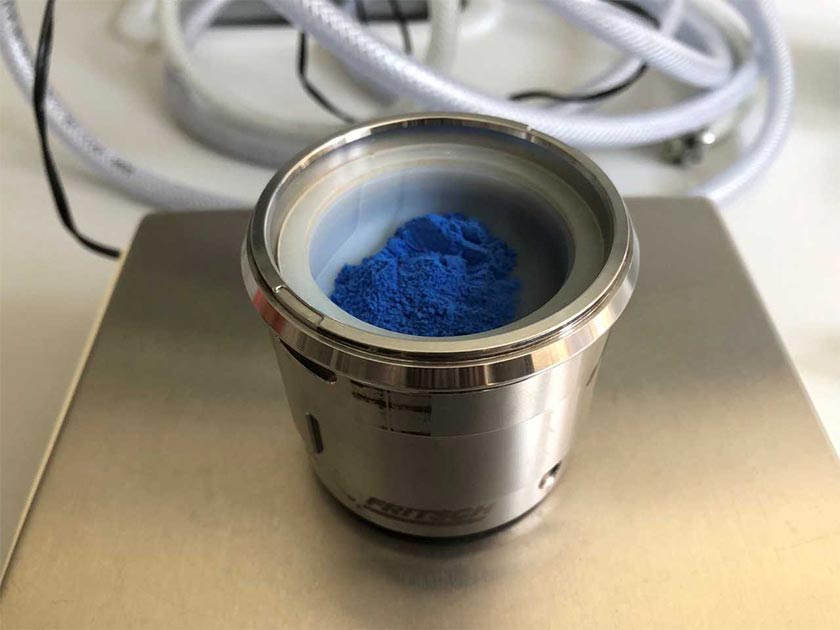Ancient Egyptian Blue Pigment Revolutionizes Biomedicine
A German research team has produced new nanosheets for near infrared imaging from ancient ‘Egyptian blue pigment’.
In October 2018, I wrote an Ancient Origins article about Egyptian blue, a brilliant blue color first created in ancient Egypt over 4000 years ago and used to adorn the crown of the world famous bust of Nefertiti. A team of scientists from the Lawrence Berkeley National Laboratory in California has now found the ancient color holds unique qualities that can not only reduce building energy consumption and boost solar energy output, but it also “increases the output of certain types of solar cells, through strong infra-red emissions.”
The international research team was led by Dr Sebastian Kruss from the Institute of Physical Chemistry at the University of Göttingen, and in a new paper published in the journal Nature Communications detailing their production of a new “nanomaterial” based on the Egyptian blue pigment. The researchers say Egyptian blue is ideally suited for applications in imaging using “near infrared (NIR) spectroscopy and microscopy,” which according to Zeiss is based on the absorption of electromagnetic (EM) radiation when light interacts with a sample and a detector measures its transmittance and absorbance.
The Science Of Egyptian Blue Pigment
Egyptian blue, or properly, “calcium copper silicate,” is one of the earliest artificial pigments created by humans and the oldest known sample is from about 5000 years old, discovered in a tomb painting dated to the reign of Ka-Sen, the last pharaoh of the First Dynasty.
By the time of the New Kingdom, Egyptian blue pigment was an extremely popular and painted onto statues, tomb paintings and sarcophagi. It was also used to produce a ceramic glaze known as ‘Egyptian faience’. And the manufacture of Egyptian blue spread beyond Egypt’s borders across Greece and Rome, leaving its trace on statues from the Parthenon in Athens, and according to an article in Art in Society, 19th century archaeologists discovered Egyptian blue pigment on wall paintings during excavations at Pompeii.

Egyptian blue pigment shabti figures on display in the Egyptian exhibit at the Louvre in France in 2006. (sataikasia / CC BY-NC-ND 3.0)
Dr. Kruss said microscopy and optical imaging are important tools in basic research and biomedicine, when light relating substances are excited and release “fluorophores” and these substances stain tiny structures in samples, enabling clear resolution using modern microscopes.
Most fluorophores shine in the range of light in the near infrared spectrum with a wavelength starting at “800 nanometers,” penetrating deep into tissue, therefore, fewer distortions are found in images. And so far, according to the new paper, there are only a few known fluorophores that work in the near infrared spectrum.
Ancient Egyptian Blue Nanosheets
The research team’s big achievement was in exfoliating extremely thin layers from grains of calcium copper silicate, Egyptian blue pigment, and these particular nanosheets are “100,000 times thinner than a human hair” and in the near infrared range, which according to Dr Sebastian Kruss, makes them “ideal for optical imaging.”

Near-infrared image of nanosheets taken from a plant. (University of Göttingen)
Egyptian blue emits infrared light when red light is shone onto it, and while it’s an extraordinarily powerful and long-lived light, it cannot be seen by the naked eye, being too deep in the infrared range of the light spectrum.
The scientists followed the movement of individual nanosheets in order to visualize mechanical processes in the structure of animal and plant tissues, for example, in the cell nuclei of the fruit fly. Furthermore, the researchers integrated the nanosheets into plants and identified them without a microscope, which the paper says promises future applications in the agricultural industry. And Dr Kruss said the potential for state-of-the-art microscopy from this material means that new findings in biomedical research can be expected in the future.
- Egyptian Blue – The Oldest Known Artificial Pigment
- History Buff Bakes Ancient Egyptian Bread Using 1,500-Year-Old Yeast Scrapings
- Nilometers: Ancient Egypt’s Ingenious Invention Used Until Modern Times
The Long Blue Light Cycle
Egyptian blue has a new role in advanced biomedical imaging with its near-infrared radiation being able to penetrate through tissue more effectively than other wavelengths, and for this same reason, because Egyptian blue splits into ‘nanosheets’ – a thousand times thinner than a human hair – if stirred in warm water for several days, it might serve as a future communication system as its emissions are similar to those used in remote controls and telecommunication devices.
Top image: Egyptian blue pigment: the researchers obtained the nanosheets from this powder. (University of Göttingen
By Ashley Cowie




















Comments
Yep. I wrote about how “Lazarus” (depicted by perceptive artists as blue) was nothing more than a relic of the Egyptian “Resurrection Cult” of Ausar (Greek: Osiris), and that Lazarus was obviously Latinized (Or Greek) of “L’Ausar”...The Blue (One). Tut had a blue 2m. high statue of Ausar in his tomb treasures. Ausar=Azure. Oddly enough, right after I wrote about it, National Geographic blog came out with an “expert” stating ancient Egypt “had no word for the color blue.” The expert’s surname? “Lazarus.” I kid you not. Ask, I’ll post the link...it is comically juvenile. Oh..and one more thing: early depictions of Osiris? He is blue, not green...with a very, very long neck...just like the blue mummy of Yuya. (Yu the Great/King Yao).
Pretty interesting. I wonder who and why first said… “You know, by George, we should look at the infrared producing capabilities of ancient egyptian pigment!"
At a pub 4 pitchers of beer in, I recogn.